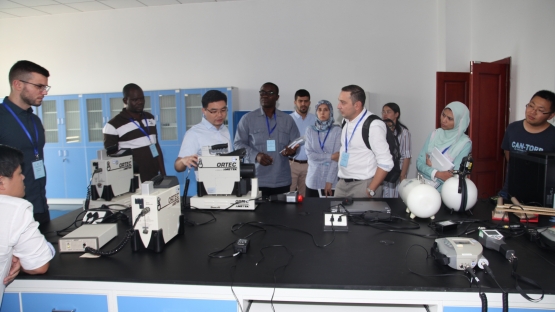Nuclear regulators, front line officers, and technical support professionals from 24 countries shared their experiences using High Purity Germanium (HPGe) detectors to maintain and strengthen nuclear security, during a virtual workshop.
The extremely sensitive HPGe detectors are critical for accurate identification and quantification of nuclear and other radioactive materials encountered in nuclear security operations ranging from detection at borders to nuclear forensics. However, the use and interpretation of the spectra measured by the HPGe detector requires advanced tools and knowledge that are not always easily available to Member State experts.
In recognition of the needs for sharing of knowledge and applications to enhance Member State abilities to use the detectors, the State Nuclear Security Technology Center (SNSTC) in Beijing, China, an IAEA Collaborating Centre in nuclear security, hosted the virtual event on 8-9 December 2020. Each day, the event drew more than 80 participants to discuss operational experiences deploying the HPGes to bolster national capabilities for detecting radioactive material that may be missing, lost or otherwise not under regulatory control.
“The high performance of an HPGe makes it a valuable tool for nuclear security detection,” said Daming Liu, Section Head at the IAEA’s Division of Nuclear Security. “The precise identification of radionuclides and measurement of their content helps countries identify the presence of nuclear or other radioactive material out of regulatory control that may be masked or shielded.”
Unlike other radiation detection equipment in use around the world, HPGe detectors can reliably and accurately identify the radionuclides present and the ratios of their composition in a small package or large shipping container. Such capability is particularly useful where there is high background radiation or when the material may be shielded or masked by the presence of other, often naturally occurring radionuclides. HPGe detectors can help distinguish between naturally occurring radioactive material (NORM), found in items such as ceramic tiles and fertilizer, and nuclear and other radioactive material that could be weaponized or harmful to those exposed to the material.
“NORM and many other radioactive sources are present in legitimate commerce and often trigger a radiation detection alarm,” said Ninh Giang Nguyen, Nuclear Security Officer of the Viet Nam Agency for Radiation and Nuclear Safety. “We must find innovative ways to quickly identify that an alarm is from an innocent, safe source and support the flow of commerce without sacrificing security concerns.”
Security and safety
If a radiation alarm is triggered, HPGe detectors generate data useful for determining the appropriate course of action by the authorities-whether from the perspective of safety, security, or both.
Countries around the world routinely report detection of contaminated scrap metal to the IAEA Incident and Trafficking Database. Understanding the isotope and quantity of the radioactive contaminant helps authorities, including technical support staff and regulators, make decisions about the appropriate radiation protection for developing disposition and further investigation approaches. The detailed analysis of the radionuclides detected can also help nuclear forensics experts trace the origin of the material and/or metal.
“When we intercepted a container with scrap metal that had caused a neutron- gamma radiation alarm, we utilized an HPGe detector to run a full gamma spectroscopy analysis,” shared Prasad Mahakumara, Director of the Radiation Protection and Technical Services Division of the Sri Lanka Atomic Energy Board. “Using the high resolution energy spectra from the HPGe and a state of the art code to assist in the interpretation of the complex spectra, we were able to identify that the exact nuclides present in the radiation source concealed inside the scrap metal container. This enabled us to determine that this was not a nuclear security event and deal with it appropriately as a radiation safety issue.”
Despite their high performance and prevalence around the world, HPGe detectors often remain underutilized by front line officers. The need to keep the detector cooled, the comparatively high purchase and maintenance costs, and the required scientific expertise to interpret the data for security and safety purposes, present an impediment to widespread use by front line officers and expert support personnel.
To bolster countries’ radiation detection capabilities, the IAEA helps build capacity among the experts by providing knowledge for the effective use of HPGe detectors for nuclear security purposes, and incidentally for radiation safety, thereby ensuring that when an HPGe detector and expert analysis are needed, the Member State is ready to respond.
Nuclear security is the responsibility of the State and international cooperation is vital to support States in establishing and maintaining effective nuclear security regimes. The IAEA collaborates with the designated Member State institutions to promote the sustainable benefits of safe and secure peaceful application of nuclear science and technology.





